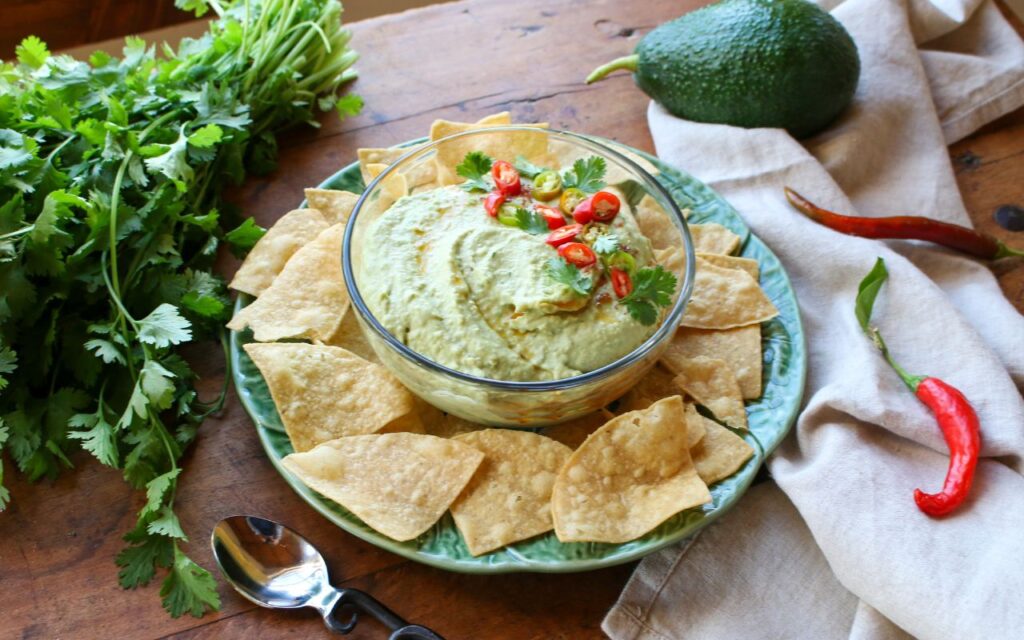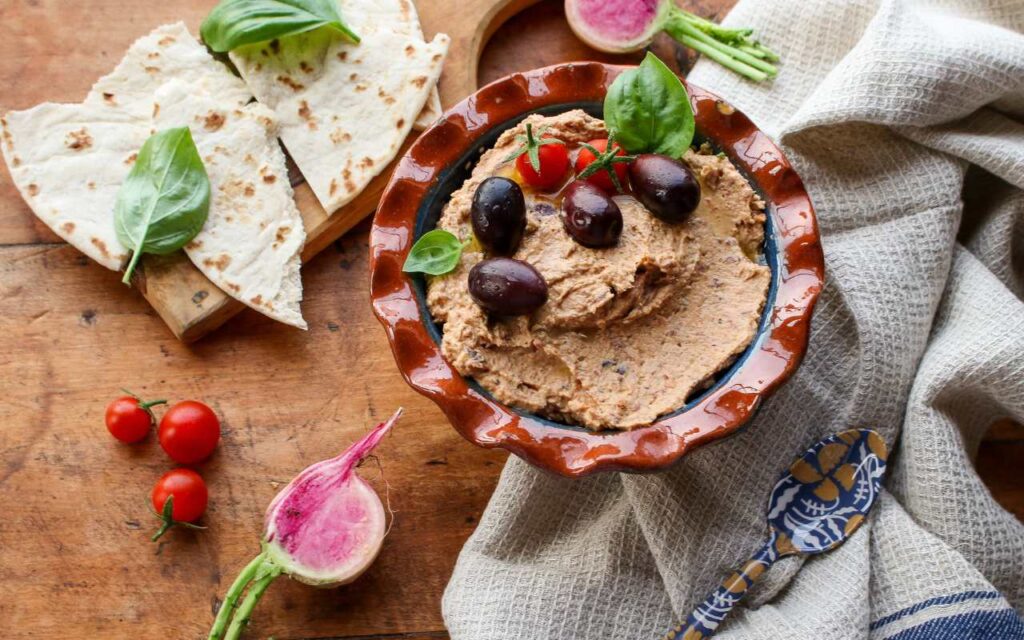Let a basic four ingredient chickpea hummus guide you down the path to other easy hummus recipes. Just start with a Classic Hummus, then add a few extra ingredients to create a Smoky Pumpkin Hummus, Avocado Cilantro Hummus, and Olive Sun-Dried Tomato Hummus. Here’s how to make hummus with 4 variations that’s sure to be perfect for your next hummus platter.
Hummus has gone from traditional Middle Eastern fare to classic American comfort food. We just can’t go a day without this creamy, flavorful dip, it seems. And it’s a good thing, as this chickpea-based spread is as healthful as it is delicious. Plus, making homemade hummus is easier than you think—just a few ingredients in the food processor and blender, and you’re set. And you can take your hummus from classic to fabulous with just a few creative additions, which are included below in this four way hummus. Make a classic hummus, and amp up the rich flavors, colors, and aromas by mixing in extra ingredients, such as spices, herbs, tomatoes, olives, and avocados.
Common Questions About Hummus
- How long does hummus last? These hummus recipes will last five days in the fridge in an air tight container.
- Can you freeze hummus? Technically, you can freeze hummus, but the textures may be slightly altered by doing so.
- Is hummus vegan? Is hummus gluten free? All of these hummus recipes below are both vegan and gluten-free. Technically, classic hummus is always both vegan and gluten-free. However, given so many extra ingredients are added to hummus these days, check the label or recipe to make sure extra ingredients aren’t added to your batch, such as yogurt, feta, cream, or breadcrumbs.
- What to eat with hummus? The sky is the limit! Serve this collection of hummus recipes with whole grain pita, fresh veggies (cherry tomatoes, carrots, broccoli florets, zucchini slices, and snap peas), toast, wraps, sandwiches, veggie burgers, vegan meatballs, salads, grain bowls, and grilled vegetables.

What Are Pulses?
Hummus is based on the key ingredient chickpeas, which is in the pulse family and includes dried beans, peas, and lentils. The pulse plant foods group is absolutely bursting with fiber—providing about 20% of the Daily Value in a single serving. Pulses, like chickpeas, are also rich in plant proteins, packing in a good source of healthy protein in every serving. It’s a great idea to dish up more plant-based meals during the week, and pulses—such as black beans, lentils, split peas, black-eyed peas, and pinto beans—can be the star of your plate. And that’s not all! Pulses are filled with other nutrients linked with health benefits, such as B vitamins, iron, and phytochemicals linked with antioxidant and anti-inflammatory properties. No wonder research suggests that eating more pulses as part of a healthy, plant-based eating plan can help you reduce your risk of chronic diseases, including heart disease, type 2 diabetes, and certain types of cancers. One of the great things about pulses is that they are so easy to include in your eating style.
Now that you have all of the inspiration you need to make your own hummus, check out this wonderful recipe for Four Way Hummus and get cooking today!
Learn how to make this hummus with this recipe video here.
How to Make Hummus: 4 Variations from 1 Starter Recipe

Best Classic Hummus
This hummus, starring nutrient-rich chickpeas, is a staple of my healthy, plant-based kitchen. Providing a rich, tasty source of plant protein, hummus offers unlimited versatility: Use it as an appetizer dip with whole grain pita bread and vegetables, spread it on sandwiches, and dollop it over salads and grains.
Ingredients:
Instructions:
- Drain the chickpeas, reserving the liquid. Put the chickpeas into a blender or food processor.
- Add the garlic, lemon juice, tahini, black pepper, and salt (optional), as well as about half of the reserved chickpea liquid.
- Puree the chickpea mixture, adding additional chickpea liquid as necessary to produce the desirable texture. Add olive oil and continue to blend until mixture is very smooth and creamy.
- Pour the hummus into a serving dish and garnish with a drizzle of additional olive oil and sprinkle of black pepper, if desired. If not serving immediately, store in an airtight container in the refrigerator for up to 3 days.
- Makes 2 cups (eight 1/4-cup servings)
Nutrition information per serving (1/4 cup): 89 calories, 3 g total fat, 0 g saturated fat, 160 mg sodium, 13 g carbohydrate, 3 g fiber, 3 g protein

Creamy Pumpkin Hummus
This smoky creamy pumpkin hummus recipe is vibrant with the flavors of chickpeas, canned pumpkin, tahini, garlic, lemon juice, and spices.
Ingredients:
Instructions:
- Prepare classic hummus according to directions 1-2 in the recipe.
- Add the pumpkin, cumin seeds, smoked paprika and enough bean liquid to make a smooth, very thick, creamy dip.
- Pour the bean dip into a serving dish.
- Garnish with a drizzle of olive oil and sprinkle of smoked paprika, and pumpkin seeds.
Nutrition information per serving: 124 calories, 5 g total fat, 1 g saturated fat, 44 mg sodium, 16 g carbohydrate, 4 g fiber, 3 g sugar, 5 g protein

Cilantro Avocado Hummus
This brightly colored and flavored hummus stars avocados, lemon zest, jalapeno, and cilantro. It’s versatile enough that you can serve it with whole grain pita and veggies, as well as tacos, burritos, and tostada salads.
Ingredients:
Instructions:
- Prepare classic hummus according to directions 1-2 in the recipe.
- Add the lime juice and zest, jalapeno, and cilantro to the blender or processor.
- Slice the avocado in half, remove the pit, and scoop out the flesh into the blender or processor.
- Puree the mixture, adding enough reserved bean liquid as necessary to produce a smooth, very thick, creamy dip.
- Pour the bean dip into a serving dish.
- Optional: garnish with a drizzle of olive oil, additional fresh cilantro, and paprika.
Nutrition information per serving: 142 calories, 8 g total fat, 1 g saturated fat, 162 mg sodium, 16 g carbohydrate, 4 g fiber, 0 g sugar, 4 g protein

Olive Sun-Dried Tomato Hummus
This rich flavors of the Mediterranean are amplified in this hummus, featuring kalamata olives, tangy sun-dried tomatoes, and verdant basil.
Ingredients:
- Classic Hummus Starter Recipe ingredients (see above)
- 1/4 cup sun-dried tomatoes, sliced
- 1 teaspoon dried basil
- 1/4 cup kalamata olives, pitted, drained
Instructions:
- Prepare classic hummus according to directions 1-2 in the recipe.
- Add the sun-dried tomatoes, basil, and kalamata olives, to the blender or food processor.
- Puree the mixture, adding reserved bean liquid as necessary to produce a smooth, very thick, creamy dip.
- Pour the dip into a serving dish.
- Optional: garnish with additional olive oil, kalamata olives, sun-dried tomatoes, and black pepper.
Note: To serve hummus as an appetizer, place a small serving dish of garnished hummus in the center of a platter. Arrange triangles of whole wheat pita bread and pieces of fresh raw vegetables, such as carrots, celery, bell peppers, mushrooms, asparagus, broccoli, and snow peas, on the platter.
Nutrition information per serving: 113 calories, 5 g total fat, 1 g saturated fat, 255 mg sodium, 15 g carbohydrate, 3 g fiber, 1 g sugar, 4 g protein
For more how to cooking guides, check out:
Try these other hummus recipes:
As an Amazon Influencer, I earn from qualifying purchases. For more information about affiliate links, click here.
https://sharonpalmer.com/how-to-make-hummus/”>
#Hummus #Variations #Starter #Recipe #Sharon #Palmer #Plant #Powered #Dietitian
